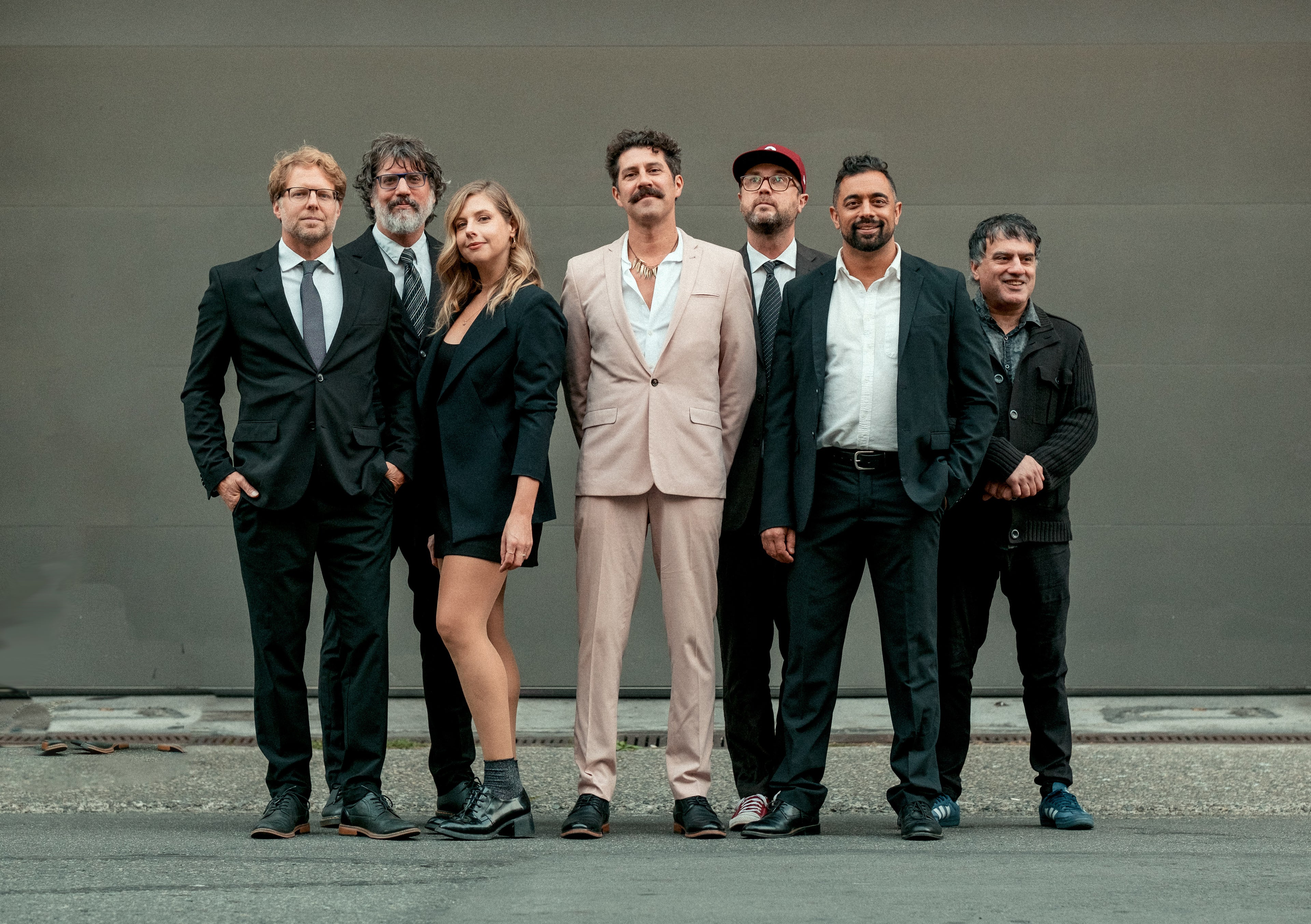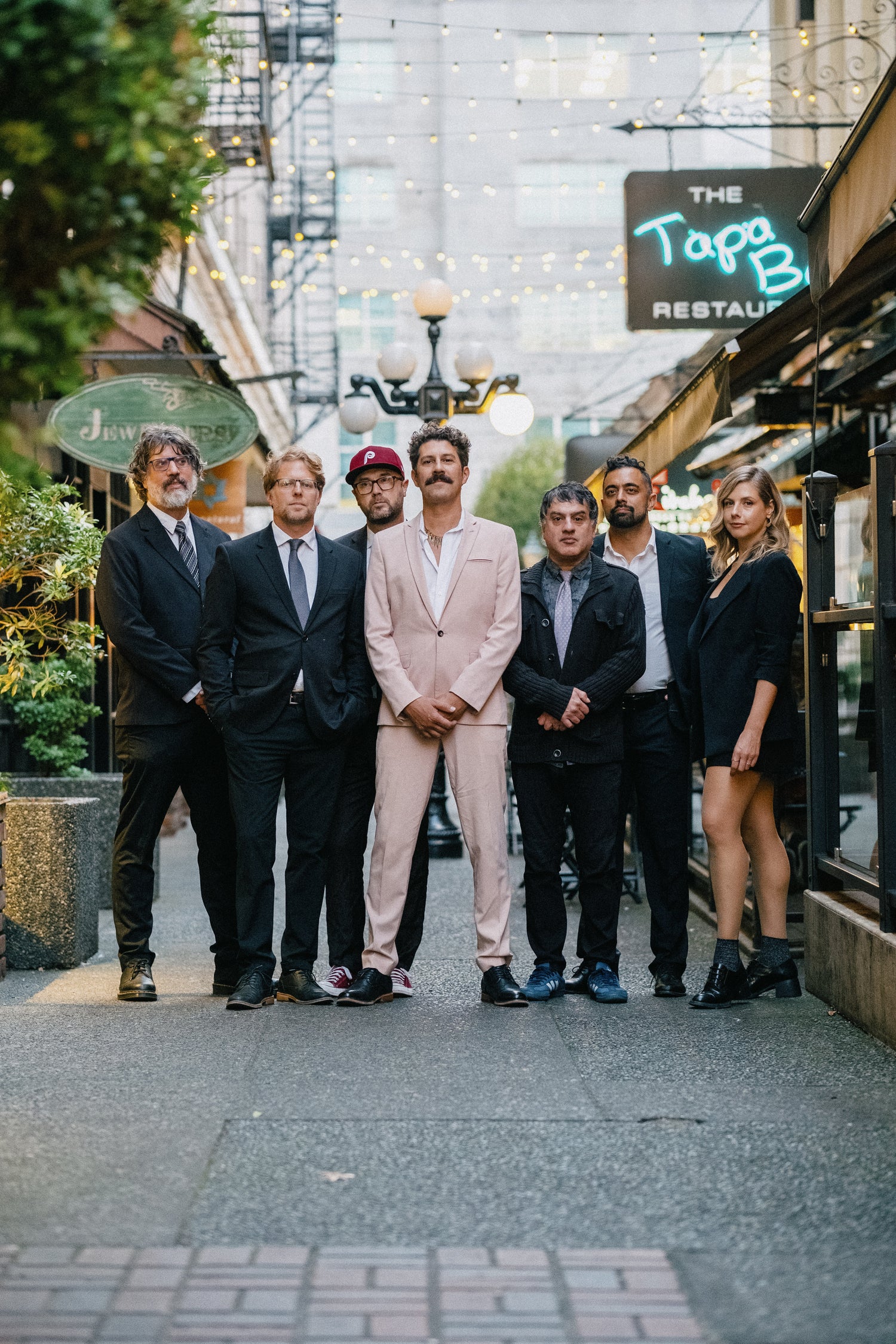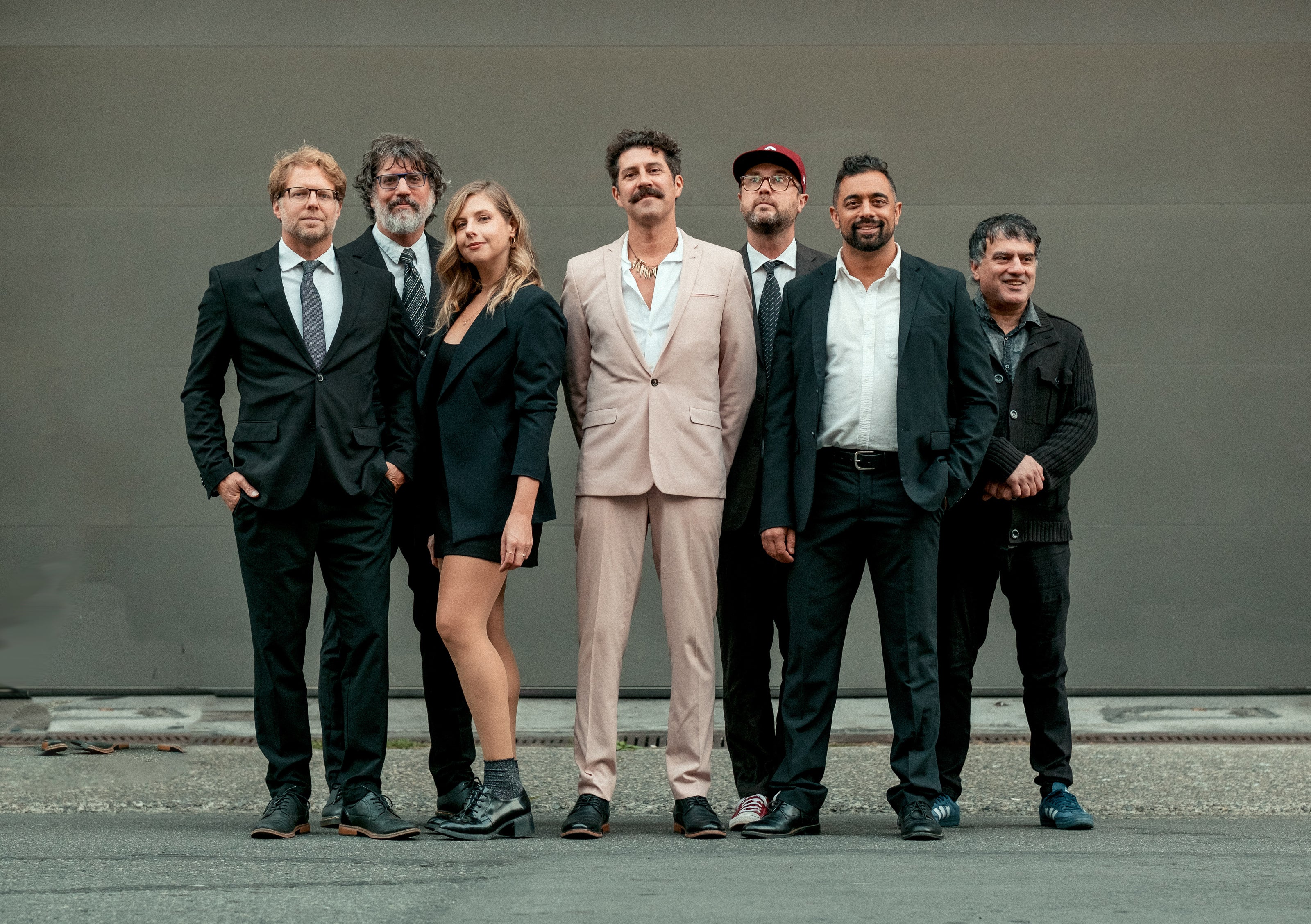
Entering Astrocolor's Creative Orbit
Interviewed by Nautica Simone
Photography by Colin McTaggart
Astrocolor, a genre-blending band from British Columbia, fuses jazz, psychedelia, and electronic influences into an experimental sound that has earned them widespread acclaim. With over 15 million streams and a win for Instrumental Artist of the Year at the 2022 Western Canadian Music Awards, the band has captivated audiences through dynamic live shows and national radio play, including CBC and KCRW.
Their latest album, Stargazing – AstroJazz Vol. 2, takes a more introspective turn, combining bebop-inspired drum grooves with deep, moody rhythms and lush, organic textures. Produced by Neil James Cooke-Dallin and Executive Producer Steve Christensen, Stargazing pushes the boundaries of experimental jazz and instrumental psychedelia.
In an exclusive conversation, Neil from Astrocolor welcomes us into the creative orbit behind their latest album—a genre-blending fusion of jazz, bebop, and electronica. Known for pushing sonic boundaries, Astrocolor takes an introspective dive with Stargazing: AstroJazz Vol. 2, exploring the depths of human emotion through moody melodies and beat-driven rhythms. Arriving just in time for cozy fall days and crisp winter nights, the album weaves trippy jazz textures with bebop-inspired drum grooves and a splash of vintage cool. It’s a lush, otherworldly journey that hits close to the heart. Ready to dive into the groove?
Can you take us back to the beginning? How did the band come together, and what was the journey like in finding and evolving your distinct sound?”
Most of the band members of Astrocolor were previously part of an improvisational funk group called Weird Party. I helped record their album which landed a record deal and that set the project in motion. Around 2016, I began noticing a resurgence of late '90s sounds, particularly from Ninja Tune. Sampling was making a comeback, and I was eager to explore it again, but without relying on the same overused jazz and soul samples.
So, I invited Weird Party to the studio for a weekend of improvisation, creating a library of sounds to sample and produce new music. The process clicked, and as we collaborated more closely, they eventually asked me to join the band as the frontman. The first albums were born from live sessions, where I’d sample the material, rearrange it, and the band would then perform it live. Over time, the collective energy turned each project into a true collaboration, with nearly every member contributing as a songwriter or producer.
Your sound is a fascinating blend of jazz, experimental, and psychedelic elements. Who are some of your favorite all-time pioneers of jazz, whether they’re from the past or present? Was there a particular album that stood out to you and inspired the band to explore these more experimental and psychedelic realms of jazz?”
Well, I'm speaking for a lot of people because there are several folks involved in Astrocolor, so I won't overstep by speaking for everyone’s inspirations. But, I can definitely say that bebop and instrumental bebop are among my favorite genres. Miles Davis, Cannonball Adderley, the list goes on. What really stands out to me from the bebop era is how drums came to the forefront. Drummers shifted from being a distant background presence to becoming key leaders, with drum solos taking center stage. For me, that shift helped shape the modern, beat-driven jazz sound we know today.
Coming from a background in beat production and DJing, this style resonates deeply, particularly with this album. I can hear that influence in Anand’s playing, as he switches between saxophone and trumpet, adding a moody Miles Davis touch. Although Anand has his own inspirations, which I’m sure he'd love to share, I think this album blends bebop’s energy with the modern sonic landscape of artists like Bonobo or Four Tet. It feels like if bebop legends teamed up with contemporary electronica artists—that’s where we’re coming from.

Building on that, would you say there’s a particular album that’s inspired you, or is it more about the artists and sounds you described?
I’d say it’s more about artists and sounds. As a producer, and within Astrocolor as a whole, we embrace changing our sound and inviting new things into each recording session. I think people are often surprised by what we’re doing next—it was psychedelic jazz, then tropical lounge, and before that, we did big-stage rave anthems.
Recently, I’ve been diving into J Dilla’s production techniques, moving back to using hardware samplers and designing beats outside the computer. Many in the band are inspired by hip-hop producers like Premier, and other '90s legends. For example, on a song like "Flash," we’ve harnessed a classic, head-nodding hip-hop beat and repetitive bassline, creating a foundation for people to explore more lyrical jazz instrumentally over it.
Jazz legends like Miles Davis and Herbie Hancock were pioneers in integrating electronic instruments, pushing the boundaries of the genre. Recently, you shared some behind-the-scenes insights from recording your latest single, where you used vintage equipment, including a classic mic for the piano, to capture a distinct sound. What inspires you to revisit older technology, and how do you see this blending of past and present shaping the evolution of your music?”
For me, producing always starts with engineering. It's about getting the right sound from the beginning. With both Stargazing Vol. 2 and Moonlighting Vol. 1, most of the recording sessions were done together, and I wanted a very traditional jazz sound. I drew inspiration from legendary engineers like Rudy Van Gelder. Instead of modern drum miking techniques, I kept it simple with a modified Glyn Johns array—just three mics on the drums—and worked closely with our drummer Amrit Basi’s style of play. That was a key decision from the start.
The same approach applied to the piano mic. I remembered a mic I loved from the past and wanted that open, organic sound, almost like documenting a moment rather than focusing on production. But with today’s tools, I also reached for modern solutions. For example, for a track like Contact, I used a concert harp sample set, playing it like a piano, to balance out the traditional sounds we captured live.
When we hit the mixing stage, I wanted Stargazing to blend seamlessly with Moonlighting. I worked to match the sonic vibe of Steve Christensen’s mix for Moonlighting, which brought in psychedelic elements with guitar pedals and more. For Stargazing, I leaned into a traditional Jamaican dub style, using faders sent to different pedals and reverbs. It was about merging traditional and modern elements to create the sound I had in mind.
Wow, that's a pretty deep process with so many different elements, technologies, and instruments involved. It’s incredible how you combined all of that into one cohesive sound.
Yeah, I’ve always had a deep love for dub music, which is why I named the studio Burning Rainbow. It wasn’t a big leap for me to get inside Steve Christensen’s mind and understand why he mixed the way he did—it felt like a kinship there. It’s part of my style too, so it came together naturally. At the end of the day, it’s all about creating lush soundscapes and trying to make things feel performative, even in the mix. I love it when things sound like they were played rather than just programmed.
Astrocolor has achieved significant recognition, including nominations at the Western Canadian Music Awards and winning Instrumental Artist of the Year in 2022—Congrats!
Thank you!
How has exposure on platforms like CBC and KCRW influenced your artistic journey? Considering these milestones are significant for any Canadian artist, how have your roots in British Columbia shaped your music and brand identity?
That's another really good question. You know, I think that on the West Coast here, specifically, there's always this underlying current of funk music. You see that right down the coast into Washington, California, and beyond. There's a thread that runs through the West Coast, and so that sound is for sure constantly invoked in Astrocolor, regardless of what other genre we're working on for any particular album. There's always going to be that little edge of funk in there—that’s definitely coming from BC.
I think some of our more ambient and spacious, thoughtful parts also have that influence. One of the things I’m most excited about with Stargazing dropping on November 1st is that I feel like it’s the perfect time of year, especially in our climate, for this album to come out. The album is very spacious and moody, and it’s all about the place where the outer world interacts with the self, evoking emotion. It’s a bit of an exploration of inner space that way.
This time of year, here, when it becomes calm and foggy, and people start to feel happy sitting inside with a tea, looking out the window, I feel like the mood of the album fits perfectly with that. So maybe that’s another way our part of the world influences the way we think about music—it comes down to even when we release it.
Your upcoming project, 'Stargazing,' features the track 'Time Internal' which gives listeners a glimpse into the album’s vibe. What else can fans expect from this new release? Are there any themes, sounds, or collaborations that you’re particularly excited to share?”
For Stargazing, we were excited to bring Lindsay Bryan into the fold. While the bed tracks were recorded before she joined, having her contribute her vocalizations—often without lyrics—really elevated the instrumental elements of the album. Her contributions were a great experiment and added a new dimension to the sound.
One standout moment is Moonglow, a vocally driven track where Lindsay beautifully interpolates a classic jazz tune over one of our existing tracks. She recorded it at home, and when we heard it, we were all blown away. It was an easy decision to include it as the one vocal track on the album.
We also collaborated with our good friend Murge, who brought his turntablism skills to the album, adding scratches and cuts that fit perfectly with our sound. Murge has been a longtime collaborator, and this was the first time we really got to integrate his unique style into our work.
The theme of Stargazing contrasts with the outward focus of Moonlighting. While the first album explored the vastness of the cosmos, this one turns inward, exploring the emotions and moods we experience through our interaction with the world. The album dives into emotions that can be anxious or somber, unafraid to engage with the full spectrum of feelings that arise as we navigate the world around us.
Is there anything that you wanted to touch on that wasn't covered—any last thoughts?
The only thing I might mention offhand is that we did a limited run of vinyl pressings for this album. We should be receiving them within the next couple of weeks and are hoping to start shipping by mid-November. I listened to the test pressing and approved it, and, having been on at least two dozen records, I can say without a doubt that this is the finest-sounding vinyl I’ve ever been part of. I’m so excited for people to hear it. If you’re a fan of vinyl, we have about 300 copies in clear purple.
You can check our website, astrocolormusic.com, for updates.
Oh, wow! Congratulations! I love vinyls, so I'll definitely be looking into those.
Right on!


